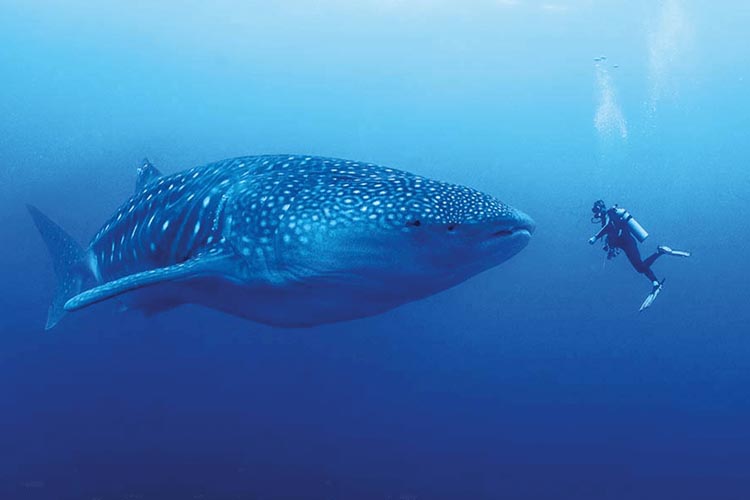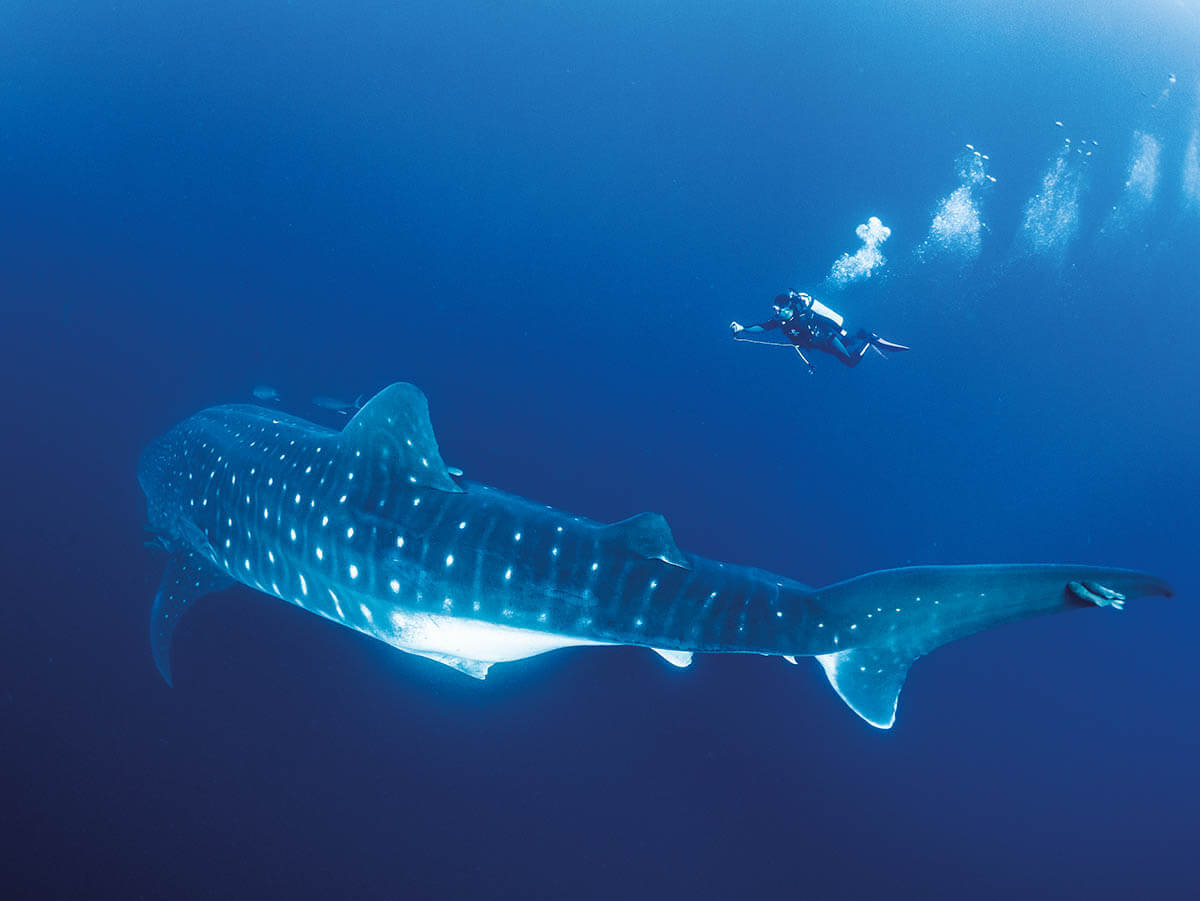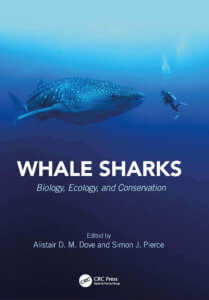
The world’s leading whale shark scientists have collaborated on the definitive guide to our largest fish. This fascinating overview of exactly what we know about whale sharks was edited by Alistair Dove and Simon Pierce. In an exclusive, edited extract we look at why they grow to such a phenomenal size
By Alistair Dove, Mark Meekan and Craig McClain
People are inherently interested in extremes, especially when it comes to animals. Exploring and identifying which member of any given animal group is the biggest, the fastest, the smallest, or the heaviest, seems to be a natural and irresistible part of human nature, and our drive to classify and measure things. Doubtless, the enormous size of whale sharks is a principal factor promoting public interest in this species, and may even be one reason why you are reading this book. In this brief introductory chapter, we explore fundamental questions about the size of whale sharks, and seek to place this extraordinary animal in a comparative context. It is not a trivial issue, not just biologically, but because body size plays a surprisingly important role in conservation. For better or worse, people tend to prioritize large animals in conservation, so the future plight of whale sharks may be tied to their tremendous size, in much the same way as is the increasing public awareness of this exceptional animal.

The whale shark body plan
The unusual features of whale sharks start at the very front: the whale shark has a terminal mouth. In other words, the mouth opens right at the front of the head, which is unlike every other extant shark species, in which the mouth is subterminal – sometimes even ventral – and preceded dorsally by a section of the body called the rostrum or snout. This rostrum varies from pointed (mako sharks, Isurus spp.) to bluntly squared (tiger sharks, Galeocerdo cuvier) to rounded (most carcharhinids or ‘typical’ sharks), or to wildly modified, as in the hammerhead, winghead, and bonnethead sharks (Sphyrnidae).
The very wide and square mouth, which can be up to 1.5m in horizontal diameter, has a side effect, which is to widely separate the nares (analogous to nostrils) of the whale shark. Much is made of the cephalofoil (the ‘hammer’) of hammerhead sharks and how it serves to separate the nares in those species, allowing them to better determine the direction of origin of smells, a sort of stereo-olfaction, if you will. But the nares of whale sharks are large and far more widely separated than those of even the largest hammerhead, it’s just less noticeable because their head lacks that iconic hammer shape. The directional smelling abilities of whale sharks must surely be excellent.
Behind the jaws lies a truly enormous orobranchial chamber that makes the whale shark effectively a ‘swimming mouth’. It extends back as far as the middle of the pectoral fins, accounting for perhaps 30 per cent of the body length. This capacious chamber houses the ten gills and 20 filter pads. Anything that enters the mouth must be swallowed or must be small enough to pass through the filter pads, or it can be ejected back out of the mouth by a motion that resembles coughing.
The skin consists of a tough, thin, pigmented outer layer or epidermis, in which the denticles are embedded, and a thick, rubbery, white dermis of dense and collagenous connective tissue. This remarkable skin may be one of their most extraordinary adaptations, providing structural support (enhanced by the ridges), insulation, and exceptional defence against both predators and well-meaning scientists trying to attach satellite tags. All but the very largest of predatory animals that attempt to bite a whale shark are going to come away with a mouth full of gristle, if anything at all.

How big is the whale shark?
The whale shark is not only the largest extant fish species, but perhaps the largest fish ever to have existed. Critical evaluation of this possibility is hampered by the poor fossilisation characteristics of sharks, where teeth are often all that is preserved, and body sizes must be extrapolated from fossil tooth sizes using scaling relationships derived from extant species. The legendary Miocene mega-predatory shark, the megalodon (Otodus megalodon) may seem comparable in size to the whale shark. However, critically evaluated size estimates of this species found that the maximum size range was likely to be 14.2–15.3m. While the fossil record is, of course, incomplete, no fish skeleton of any species has yet been discovered that was longer than 18m and thus it appears that the whale shark really is the all-time record holder.
It has been recently proposed that significantly different growth trajectories may exist for male and female whale sharks. Male growth curves tend to asymptote (slow down) at the onset of maturity, which occurs at an average adult size of 8.0–9.0m, whereas female growth curves do not appear to follow an asymptotic pattern, instead continuing to a larger average size of 12 –14.5m. This suggests that when we are considering the body size of the largest whale sharks, we will generally be talking about females. Researchers interested in demography of whale sharks often comment on the apparent lack of really big males, concluding that they must be in some part of the ocean as yet undiscovered. But perhaps we don’t find really big males because there aren’t any, or many, at least.
Notwithstanding the potential differences in growth trajectories of males and females, we can confidently say that the majority of adult whale sharks are probably between 9m and 13m in length and, from any viewpoint, that’s objectively a very big fish.

How big is the whale shark relative to other large marine animals?
Compared to its closest relatives, which are other members of the shark order Orectolobiformes (carpet sharks), the body size of whale sharks is extremely divergent. The largest tawny nurse shark, which is the next biggest orectolobiform shark and the whale sharks’ closest relative, is around 4m in maximum size, or less than a quarter of the length of the largest whale sharks. Not surprisingly, whale sharks are also genetically distinct within the phylogeny of this order. This evolutionary distinctiveness mirrors an ecological divergence, too: most orectolobiform sharks are sluggish bottom-dwelling predators, whereas the whale shark is the only one that is pelagic and planktivorous.
In comparison with other shark species outside the Orectolobiformes, only the basking shark approaches the whale shark in size and, even then, not very closely. The largest basking shark documented was just over 12m in length, so the difference in maximum length between these two species (6.8m) is larger than the maximum size of almost all other shark species! Although the whale shark and basking shark are both filter feeders, the two species are not closely related, and their filtering mechanisms are very different and certainly evolved independently
The third filter-feeding shark, the megamouth Megachasma pelagios, is also relatively large at around 6m in total length, although only half the size of basking sharks and a third of the size of the largest whale shark. Megamouth sharks are more closely related to basking sharks than to whale sharks but their filtration apparatus is different from either of the other two species, suggesting that filter feeding has appeared at least three separate times in the evolutionary history of sharks, four if you include extinct filter-feeding taxa. Among the apex predatory sharks, at just over 7m in length the largest great white sharks, Carcharodon carcharias, are smaller than many juvenile whale sharks and roughly a third of the length of the largest recorded whale shark. So, the white shark may be ‘great’ relative to other apex predatory sharks, but it is relatively puny compared to the whale shark.
Why is the whale shark so large?
The anatomical and ecological uniqueness of whale sharks suggests a long, lonely, and distinct evolutionary path, but is their extraordinary body size a result of phylogeny (that is, their evolutionary ancestry) or their ecology? Evidence argues against phylogeny as the only explanation for whale shark gigantism. Whale sharks are the only species in their genus, which is, in turn, the only extant genus in its family, which is in an order whose other members are all demersal species of unremarkable size relative to other shark species. There is another rhincodontid known from the fossil record – Palaeorhincodon Herman 1975 – the fossils of which are distributed broadly across the globe and include at least four putative species. As with many sharks, the descriptions of these four species are all are based exclusively on measurements of fossil teeth. Although the fossils of Palaeorhincodon are from the Eocene at least 166 million years ago, and therefore predate the earliest appearance of fossilised Rhincodon teeth in Oligocene formations 23 million years ago, the relationship of these genera to each other and to their most recent common ancestor has not been established. If other gigantic members of the Orectolobiformes ever existed, none of them are represented in the current fossil record. The whale shark is the only remaining gigantic member of this order and does not seem to represent a remnant of some previous speciose radiation of giant carpet sharks, and so we must look elsewhere than the phylogenetic constraints on orectolobiforms for the explanation of the whale shark’s extraordinary size.
When it comes to extremely large body size in the ocean, there is a clear correlation with planktivorous feeding habits, regardless of taxon. The largest whales are the planktivorous mysticetes, the two largest sharks are also planktivores, and the largest batoid elasmobranchs, the manta rays, are also filter feeders. So, perhaps a better and more generalised question is ‘are animals able to become planktivores because they are so large or do large sizes result from planktivory?’
The size of whale sharks means that they can use the heat captured at the surface by basking, and from warmer surface waters, and retain it within their very large bodies to be able to swim and feed in deep, cold water. This strategy of evolving a very large body size to stabilise and maintain temperatures is known as ‘gigantothermy’ and is an adaptation shared with leatherback turtles today, and the extinct sauropod dinosaurs of the Mesozoic.
Why isn’t the whale shark larger?
While it is interesting to explore how whale sharks come to be large, we must also ask ‘Why isn’t the whale shark even larger?’ Given that whale sharks have adopted the same planktivorous habits as the mysticete or baleen whales, why have whale sharks not achieved the same body sizes seen in that group? The first explanation concerns the biomechanics of cartilaginous fishes. The robust and truly bony skeletons of marine mammals can support larger body sizes than those that can be supported by the rib-less, flexible, cartilaginous skeletons of sharks and rays. Furthermore, the rigid bony skeletons of whales can withstand the tremendous mechanical stresses of lunge-feeding enormous volumes of water. Whale sharks, on the other hand, have a quite different and very efficient feeding mechanism, which does not rely on lunge feeding and is thus much less mechanically stressful.
The upper limit of body size in whale sharks may also be set by energetic constraints. In mysticete whales, the energy demands of increasingly large body sizes trade off against the ever-higher energetic costs of lunge feeding, which may be many times the basal metabolic rate. At the upper size limit, the cost of feeding exceeds the energy that can be harvested from even the densest food patches. Could a similar upper limitation exist for whale sharks? While the cost of feeding is lower in whale sharks than in whales, whale sharks also live and, importantly, feed in the relatively nutrient-poor tropics. So, it remains possible that it becomes difficult for whale sharks to harvest enough energy to sustain their metabolic needs beyond their contemporary body size.
Can size save the whale shark?
Evidence is accumulating that body size may be an important factor in how humans approach conservation initiatives, and this obviously has significant implications for whale sharks. For example, larger animals are more popular in zoos, with guests willing to pay more money to symbolically adopt larger animals than smaller. Similarly, animals featured on the covers of popular nature magazines tend to be large-bodied, regardless of taxon or even conservation status. The attachment of greater cultural value to animals based on their size has given rise to terms like ‘charismatic megafauna’ to capture the idea that very large animals are in some way more appealing, better, or more important than smaller ones. This is a completely arbitrary distinction, of course, and yet true nonetheless.
Conservation practitioners would do well to model efforts to protect whale sharks after the successful ‘Save the whales’ and ‘Save the panda’ campaigns of the late 20th century, which have been extraordinarily effective in bringing many mysticetes and the giant panda back from the brink of extinction. There seems little doubt that the large body size and peaceful behaviour of these animals contributed to increases in their perceived value in the eyes of the public, once they were made aware of their conservation plight.
In conclusion
There is no doubt that the whale shark is the largest shark and the largest extant fish of any kind, and it seems likely to be the largest fish ever to have swum in the world’s oceans. Some questions remain to be answered about the body size of whale sharks and how it relates to their lifestyle. For example, we still do not know which factors limit the body size of whale sharks. We do not understand the genetic basis of gigantism in whale sharks nor indeed of most other species. The availability of the complete whale shark genome may be a useful tool in the search for a genotypic mechanism to explain such a divergent phenotype. Finally, questions remain about the precise relationship between body size and body temperature in this species. Is it just thermal stability, or passive gigantothermy, or do whale sharks have specific adaptations for partial endothermy, as occur in many other pelagic species? While scientists seek the answers to these questions, the sheer mind-blowing size of these ocean giants will continue to captivate the scientific community and the public alike.

Whale Sharks: Biology, Ecology, and Conservation
Edited by Alistair DM Dove and Simon J Pierce
CRC Press, £72
Order your copy from the DIVE Books
Read an interview with Simon Pierce – co-editor of Whale Sharks and co-founder of the Marine Megafauna Foundation


